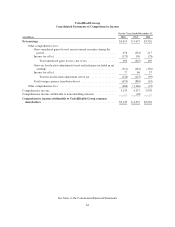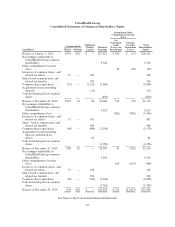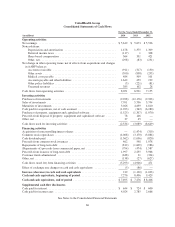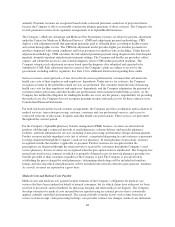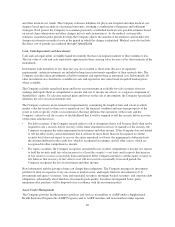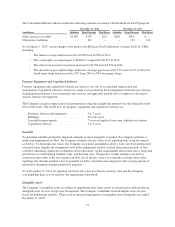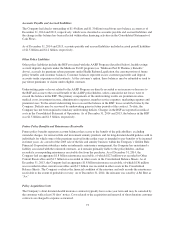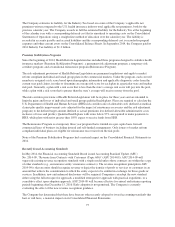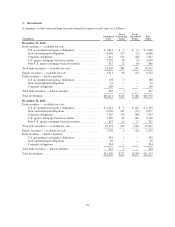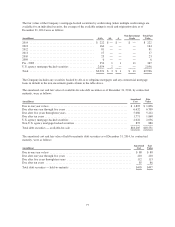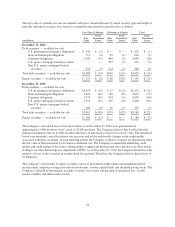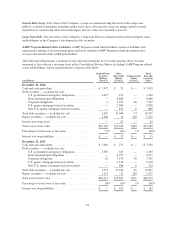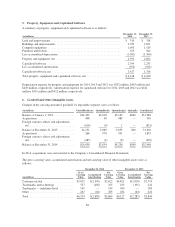United Healthcare 2014 Annual Report Download - page 76
Download and view the complete annual report
Please find page 76 of the 2014 United Healthcare annual report below. You can navigate through the pages in the report by either clicking on the pages listed below, or by using the keyword search tool below to find specific information within the annual report.
Redeemable Noncontrolling Interests
Noncontrolling interests in the Company’s subsidiaries whose redemption is outside the control of the Company
are classified as temporary equity. The redeemable noncontrolling interests are primarily related to non-public
shareholders of Amil. The following table provides details of the Company’s redeemable noncontrolling interests
activity for the years ended December 31, 2014 and 2013:
(in millions) 2014 2013
Redeemable noncontrolling interests, beginning of period ............................. $1,175 $ 2,121
Net earnings ................................................................. — 48
Acquisitions ................................................................. 203 360
Redemptions ................................................................ — (1,417)
Distributions ................................................................. (40) —
Fair value and other adjustments ................................................. 50 63
Redeemable noncontrolling interests, end of period .................................. $1,388 $ 1,175
During 2013, the Company increased its ownership of Amil to 90% by acquiring all of Amil’s remaining
publicly-traded shares.
Share-Based Compensation
The Company recognizes compensation expense for share-based awards, including stock options, stock-settled
stock appreciation rights (SARs) and restricted stock and restricted stock units (collectively, restricted shares), on
a straight-line basis over the related service period (generally the vesting period) of the award, or to an
employee’s eligible retirement date under the award agreement, if earlier. Restricted shares vest ratably;
primarily over three to four years and compensation expense related to restricted shares is based on the share
price on date of grant. Stock options and SARs vest ratably over four to six years and may be exercised up to 10
years from the date of grant. Compensation expense related to stock options and SARs is based on the fair value
at date of grant, which is estimated on the date of grant using a binomial option-pricing model. Under the
Company’s Employee Stock Purchase Plan (ESPP) eligible employees are allowed to purchase the Company’s
stock at a discounted price, which is 85% of the lower market price of the Company’s common stock at the
beginning or at the end of the six-month purchase period. Share-based compensation expense for all programs is
recognized in operating costs in the Company’s Consolidated Statements of Operations.
Net Earnings Per Common Share
The Company computes basic net earnings per common share by dividing net earnings by the weighted-average
number of common shares outstanding during the period. The Company determines diluted net earnings per
common share using the weighted-average number of common shares outstanding during the period, adjusted for
potentially dilutive shares associated with stock options, SARs, restricted shares and the ESPP, (collectively,
common stock equivalents) using the treasury stock method. The treasury stock method assumes a hypothetical
issuance of shares to settle the share-based awards, with the assumed proceeds used to purchase common stock at
the average market price for the period. Assumed proceeds include the amount the employee must pay upon
exercise, any unrecognized compensation cost and any related excess tax benefit. The difference between the
number of shares assumed issued and number of shares assumed purchased represents the dilutive shares.
Industry Tax
Health Reform Legislation includes an annual, nondeductible insurance industry tax (Industry Tax) to be levied
proportionally across the insurance industry for risk-based health insurance products that began on January 1,
2014.
74


